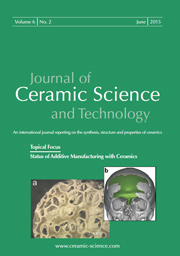Articles
All articles | Recent articles
Reaction Heat Utilization in Aluminosilicate-Based Ceramics Synthesis and Sintering
M. Karhu1, J. Lagerbom1, P. Kivikytö-Reponen1, A. Ismailov2, E. Levänen2
1 VTT Technical Research Centre of Finland Ltd, Sinitaival 6, P.O. Box 1300, FI-33101 Tampere, Finland
2 Tampere University of Technology, Korkeakoulunkatu 10, P.O. Box 527, FI-33101 Tampere, Finland
received November 2, 2016, received in revised form December 16, 2016, accepted January 19, 2017
Vol. 8, No. 1, Pages 101-112 DOI: 10.4416/JCST2016-00094
Abstract
Self-propagating high-temperature synthesis (SHS) is a widely known and extensively studied highly exothermic-reaction-utilizing technique for making certain advanced composites and intermetallic compounds. However, only few studies have been published about the SHS of pure aluminosilicate ceramics. In the current work, possibilities for aluminosilicate ceramic synthesis and sintering requiring less energy based on the utilization of SHS in air was studied. Kaolinite powder and exothermically reactive metallic aluminium powder were used as raw materials. Thermodynamic calculations for the possible reactions and reaction paths were performed to show the theoretical possibilities for SHS utilization. The chemical reactions, thermal expansion behaviour and formed phase- and microstructures after SHS were compared to the conventional reaction sintering of mullite. Results conclude that highly exothermic reactions above 900 °C relating mainly to aluminium oxidation can ignite the SHS reaction in air atmosphere. After initialization, the reaction proceeded in a self-sustaining manner through entire test pieces, resulting in the formation of an Al2O3 - Si phase structure. Thermodynamic calculations showed the total energy balance for mullite formation from aluminium and kaolinite mixtures as highly exothermic in nature only if sufficient oxygen is available to complete the reactions. However, future research is needed to fully utilize SHS in aluminosilicate ceramics processing.
![]() Download Full Article (PDF)
Download Full Article (PDF)
Keywords
Aluminosilicate ceramics, self-propagating high-temperature synthesis, SHS, exothermic reactions, synthesis, sintering
References
1 Kang, T.S., Park, C-H., Kim, S.H.: Characteristics of exothermic reaction fronts in the gasless combustion system, Ceram. Int., 37, 825 – 833, (2011).
2 Merzhanov, A.G.: History and recent developments in SHS, Ceram. Int., 21, [5], 371 – 379, (1995).
3 Cao, G., Orrù, R.: Self-propagating reactions for environmental protection: State of the art and future directions, Chem. Eng. J., 87, [2], 239 – 249, (2002).
4 Mossino, P.: Review some aspects in self-propagating high-temperature synthesis, Ceram. Int., 30, 311 – 332, (2004).
5 Dong, Y., Feng, X., Feng, X., Ding, Y., Liu, X., Meng, G.: Preparation of low-cost mullite ceramics from natural bauxite and industrial waste fly ash, J. Alloy. Compd., 460, 599 – 606, (2008).
6 Zaki, Z.I., Ewais, E.M.M., Rashad, M.M.: Review novel route for combustion synthesis of zirconia-mullite/TiB2 composites, J. Alloy. Compd., 467, 288 – 292, (2009).
7 Chen, C.Y., Lan, G.S., Tuan, W.H.: Preparation of mullite by the reaction sintering of kaolinite and alumina, J. Eur. Ceram. Soc., 20, 2519 – 2525, (2000).
8 Zaki, Z.I.: Combustion synthesis of mullite-titanium boride composite, Ceram. Int., 35, 673 – 678, (2009).
9 Chen, Y-F., Wang, M-C., Hon, M-H.: Phase transformation and growth of mullite in kaolin ceramics, J. Eur. Ceram. Soc., 24, 2389 – 2397, (2004).
10 Yeh, C.L., Kao, W.C.: Preparation of TaB/TaB2/mullite composites by combustion synthesis involving aluminothermic reduction of oxide precursors, J. Alloy. Compd., 615, 734 – 739, (2014).
11 Esharghawi, A., Penot, C., Nardou, F.: Elaboration of porous mullite-based materials via SHS reaction, Ceram. Int., 36, [1], 231 – 239, (2010).
12 Podbolotov, K.B., Dyatlova, E.M., Popov, R. Yu.: Ceramic refractory SHS-coatings based on the system, Al-SiO2, Refract. Ind. Ceram., 54, [5], 31 – 36, (2014).
13 Kazhikenova, S. Sh., Nurkenov, O.A., Satbaev, B.N.: Theoretical aspects of the creation of highly efficient refractories on the basis of SHS technology, Refract. Ind. Ceram., 52, [1], 55 – 60, (2011).
14 Zharmenov, A.A., Satbaev, B.N., Kazhikenova, S. Sh., Nurkenov, O.A.: Development of refractory materials prepared by SHS technology, Refract. Ind. Ceram. 52, [4], 40 – 48, (2011).
15 Zharmenov, A.A., Satbaev, B.N., Kazhikenova, S. Sh., Nurkenov O.A.: Development of new refractory material by SHS-technology based on kazakhstan republic raw material resources, Refract. Ind. Ceram., 53, [3], 47 – 54, (2012).
16 Mansurov Z.A., Mofa N.N., Sadykov B.S., Sabaev Zh. Zh., Bakkara A.E: Mechanochemical treatment, structural peculiarities, properties, and reactivity of SHS systems based on natural materials. 4. Production of SHS ceramics based on mechonoactivated materials, J. Eng. Phys. Thermophys., 89, [1], 230 – 237, (2016).
17 Balmori-Ramirez, H.: Dense mullite from attrition-milled kyanite and aluminum metal, J. Am. Ceram. Soc., 87, [1], 144 – 146, (2004).
18 Esharghawi, A., Penot, C., Nardou, F.: Contribution to porous mullite synthesis from clays by adding al and mg powders, J. Eur. Ceram. Soc., 29, [1], 31 – 38, (2009).
19 Khabas, A., Nevvonen, O.V., Vereshchagin, V.I.: Synthesis of mullite in the presence of nanodisperse aluminium powder, Refract. Ind. Ceram., 46, [1], 71 – 75, (2005).
20 Anggono, J., Derby, B.: Mullite formation from the pyrolysis of aluminium-loaded polymethylsiloxanes: the influence of aluminium powder characteristics, J. Eur. Ceram. Soc., 26, [7], 1107 – 1119, (2006).
21 Trunov, M.A., Schoenitz, M., Zhu, X., Dreizin, E.L.: Effect of polymorphic phase transformations in Al2O3 film on oxidation kinetics of aluminum powders, Combust. Flame, 140, 310 – 318, (2005).
Copyright
Göller Verlag GmbH


